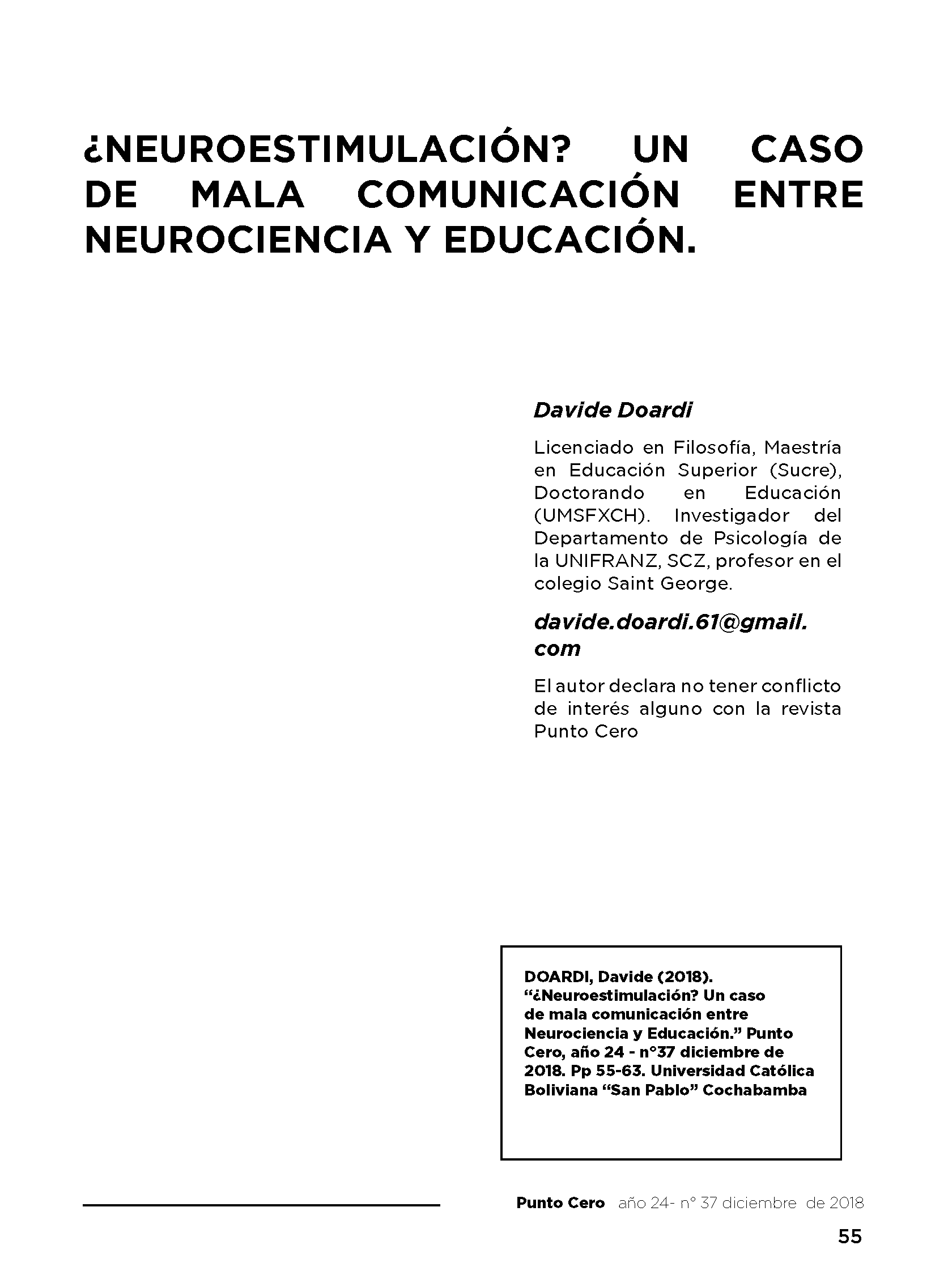¿Neuroestimulación? Un caso de mala comunicación entre Neurociencia y Educación.
DOI:
https://doi.org/10.35319/puntocero.20183742Palabras clave:
Didáctica, Emergentismo, Neuroeducación, PedagogíaResumen
La relación actual entre Educación y Neurociencias es asimétrica: público e investigadores ven en las Neurociencias el conocimiento científico apto para guiar la actividad pedagógica sin ulteriores mediaciones, y en el prefijo ‘neuro’ un ascenso de estatus profesional. Objetivo de este artículo es argumentar que esto no es posible, en línea de principio, y no por falta de formación interdisciplinaria. El marco epistemológico y ontológico es la teoría filosofía del emergentismo. La argumentación es complementada por el análisis de dos ejemplos de fallido connubio entre educación y neurociencia. En conclusión, como la neuroeducación en el sentido señalado es fundamentalmente una equivocación, se recomienda modificar las expectativas. También se sugieren algunas líneas de investigación hacia problemas de real interés para la didáctica, compatibles con la autonomía entre Educación y Neurociencias.
Citas
ÁGUILA, José Ramón Torres. (2005). El mito del período crítico para el aprendi- zaje de la pronunciación de un idioma ex- tranjero. Phonica, 1, 1-9
ANDERSON, O. Roger. (1992). Some inte- rrelationships between Constructivist Mo- dels of Learning and Current Neurobiolo- gical Theory, with implications for Science Education. Journal of Research in Science Teaching, 29(10), 1037-1058.
ANSARI, Daniel; DE SMEDT, Bert; GRAB- NER, Roland H. (2012), Neuroeducation–a critical overview of an emerging field. Neuroethics, 5(2), 105-117.
ANSARI, Daniel; KÖNIG, Johannes; LEASK, MARILYN, TOKUHAMA-ESPINO- SA, Tracey. (2017). Developmental Cog- nitive Neuroscience: Implications for tea- chers’ pedagogical knowledge, In Sonia GUERRIERO (Ed.), Pedagogical Knowle- dge and the Changing Nature of the Tea- ching Profession. Paris: OECD.
ANSARI, Daniel; COCH, Donna. (2006). Bridges over troubled waters: Education and cognitive neuroscience. Trends in cognitive sciences, 10(4), 146-151.
BOWERS, Jeffrey S. (2016). Psychology, not educational neuroscience, is the way forward for improving educational out- comes for all children: Reply to Gabrieli (2016) and Howard-Jones et al. (2016). Psychological Review, 123(5), 628-635.
BOWERS, Jeffrey S. (2016a). The prac- tical and principled problems with edu- cational neuroscience. Psychological Re- view, 123(5), 1-13.
BROAD, Charlie Dunbar. (1925). The Mind and Its Place in Nature. London: Routled- ge & Kegan.
BRUER, John T. (1997). Education and the Brain: A Bridge Too Far. Educational Re- searcher, 26(8), 4-16.
BRUER, John T. (2016). Where is Educa- tional Neuroscience? Educational Neuros- cience, 1, 1-12.
BUTTERWORTH, Brian; VARMA, Sashank; LAURILLARD, Diana. . (2011) Dyscalculia: from brain to education, Science, 332, 1049 – 1053.
CORTÉS MORENO, Maximiano (2001). El factor edad en el aprendizaje de una lengua extranjera, una revisión teórica. ADAXE – Revista de Estudios y Experien- cias Educativas, 17, 269-285.
DYSTEFL (2012). Dyslexia for teachers of English as a Foreign Language. Univer- sity of Lodz. Recuperado: http://dystefl.eu/index.php?id=20 Ultimo acceso: 4 No- viembre 2017
SLAVIN, Konstantin V.; ELJAMEL, Sam (2013). Neurostimulation: Principles and practice. Chichester, West Sussex: Wiley Blackwell.
FRITH, Utha; BISHOP, Dorothy; BLAKE- MORE, Colin; BLAKEMORE, Sara-Jane; BUTTERWORTH, Brian; GOSWANI, Usha. (2013). Neuroscience: implications for education and lifelong learning. Integrating Science and Practice, 3 (1), 6-10
GOSWANI, Usha. (2015). Neurociencia y Educación: ¿podemos ir de la investigación básica a su aplicación? Un posible marco de referencia desde la investigación en dislexia. Psicología Educativa, 21, 97–105.
HARDIMAN, Mariale; RINNE, Luke; GRE- GORY, Emma; YARMOLINSKAYA, Julia. (2012). Neuroethics, neuroeducation, and classroom teaching: Where the brain sciences meet pedagogy. Neuroethics, 5(2), 135-143.
HESS, Eckhard H. (1958). Imprinting in animals. Scientific American, 198(3), 81-90.
HESS, Walter Rudolf (1925). Über die Wechselbeziehungen zwischen psychischen und vegetativen Funktionen. Zürich: Orell Füssli.
HORVATH, Jared C.; DONOGHUE, Gregory M. A (2016). A bridge too far–re- visited: reframing Bruer’s neuroeducation argument for modern science of learning practitioners. Frontiers in psychology, 7, 1-12.
HOWARD-JONES, Paul A. (2014). Neuros- cience and education: myths and messages. Nature Reviews Neuroscience, 15(12), 817–824
HOWARD-JONES, Paul A.; VARMA, Sashank; ANSARI, Daniel; BUTTERWORTH, Brian; DE SMEDT, Bert; GOSWAMI, Usha; LAURILLARD, Diana; THOMAS, Michael (2016). The principles and practices of educational neuroscience: Comment on Bowers (2016). Psychological Review, 123(5), 620-627.
LALANCETTE, Hélène; CAMPBELL, Stephen R. (2012). Educational Neuroscience: Neuroethical Considerations. International journal of environmental and science education, 7(1), 37-52.
LENNEBERG, Eric H. (1967). Biological foundations of language. New York: John Wiley and Sons.
LORENZ, Konrad (1935). Der Kumpan in der Umwelt des Vogels. Der Artgenosse als auslösendes Moment sozialer Verha tensweisen. Journal für Ornithologie, 83, 137–215.
MENDOZA, Luis; CABALLERO, Solange; ORMEA, Verónica; AQUINO, Ruth; YAYA, Elena; PORTUGAL, Alan; GOMEZ, Jose; PORTUGAL, Alan; ZAVALETA, Juana; MUÑOZ, Ana. (2017). Neurociencia del sueño: rol en los procesos de aprendizaje y calidad de vida. Apuntes de Ciencia & Sociedad, 7(2), 103 –109.
NICOLSON, Roderick I.; FAWCETT, Angela J. . (2018). Procedural learning, dyslexia and delayed neural commitment. In Thomas LACHMANN .& Tina WEIS (Eds.), Reading and dyslexia. Springer: Cham. PARRINO, Liborio; VAUDANO, Anna Elisa- betta. (2017). The resilient brain and the guardians of sleep: new perspectives on old assumptions. Sleep Medicine Reviews, 30, 1-10.
SCHRAG, Francis. (2013). Can this marriage be saved? The future of ‘neuroeducation’. Journal of Philosophy of Education, 47(1), 20-30.
SCHWARTZ, Michael D.; KILDUFF, Thomas S. (2015). The neurobiology of sleep and wakefulness. The Psychiatric clinics of North America, 38(4), pp. 1-32.
SIEVERTSEN, Hans Henrik; GINO, Francesca; PIOVESAN, Marco. (2016). Cognitive fatigue influences students’ performance on standardized tests. Proceedings of the National Academy of Sciences, 113(10), 2621-2624.
TURNER, David A. (2012). Education and neuroscience. Contemporary Social Science: Journal of the Academy of Social Sciences, 7 (2), 167-179.
WEISBERG, Deena; KEIL, Frank; GOODS- TEIN, Joshua; RAWSON, Elisabeth; GRAY, Jeremy. (2008). The Seductive Allure of Neuroscience Explanations. Journal of Cognitive Neuroscience, 20, 470–477.
WEISBERG, Deena Skolnick; TAYLOR, Jordan CV; HOPKINS, Emily J. (2015). De- constructing the seductive allure of Neuroscience Explanations. Judgment and Decision Making, 10(5), 429-441.
ZADINA, Janet N . (2015). The emerging role of educational neuroscience in education reform. Psicología Educativa, 21(2), 71-77.

Descargas
Publicado
Cómo citar
Número
Sección
Licencia
Derechos de autor 2018 Revista Punto Cero

Esta obra está bajo una licencia internacional Creative Commons Atribución-NoComercial 4.0.








